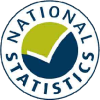Higher Education Student Statistics: UK, 2016/17 - Where students come from and go to study
- Summary
- Student numbers and characteristics
- Where students come from and go to study
- Subjects studied
- Qualifications achieved
- Notes
Where are students in HE studying?
In 2016/17, 167 HE providers reported student data to HESA. Figure 6 shows the number of students studying at each HE provider in the UK in 2016/17, with a breakdown by the geographic location of students' permanent home address prior to study (known as domicile).
Figure 6 - HE student enrolments by HE provider and domicile
2016/17
Reset sort | Download table (csv) | About SFR247 Figure 6
HESA does not collect information on UK students who go abroad to study, but more information on these students can be found through United Nations Educational, Scientific and Cultural Organization (UNESCO).
Where do HE students come from?
Figures 7 and 8 show that 81% of all students at UK HE providers came from the UK in 2016/17. This figure has been the same since 2013/14. In 2016/17, 6% of students were from other European Union (EU) countries and the remaining 13% came from countries outside the EU. Proportions of students from outside the UK varied by both level and mode of study in 2016/17. UK students made up the majority of enrolments for all modes and levels of study. Full-time postgraduates had the highest percentage from non-EU countries, at 42%.
Proportions of students from outside the UK also varied across the four administrations. HE providers in England had the greatest proportion of non-EU students at 14%, while providers in Scotland had the greatest proportion of other EU students at 9%. Figure 8 shows that at HE providers in Wales, there was a large decrease of 25% in the number of non-EU students between 2013/14 and 2016/17, although over the same time period Scotland had a 9% increase in the number of non-EU students. Northern Ireland experienced a decrease in non-EU numbers of 12% between 2013/14 and 2016/17.
Despite the EU referendum (Brexit) result in June 2016, there has been no drop in the number of students from other EU countries between 2015/16 and 2016/17 (although most students starting their first year of studies in 2016/17 would have applied for their course prior to June 2016). Non-EU students enrolling in their first year of study in 2016/17 accounted for 6% of the overall number of students at UK universities. This percentage was the same in 2015/16.
Figure 7 - HE student enrolments at HE providers in the UK by level of study, mode of study and domicile
2016/17
Figure 8 - HE student enrolments by domicile
2012/13 to 2016/17
Figure 9 shows the cross-border flows of first year students from the UK by the country of domicile and country of provider. Across all regions the majority of students stay in their home country, although those from Wales and Northern Ireland were more likely to cross borders than those from England and Scotland. Of first year students from Wales, 26% were enrolled at HE providers in England, and of first year students from Northern Ireland, 20% were enrolled at HE providers in England.
Figure 9 - UK domiciled first year HE student enrolments by domicile and country of HE provider
2016/17
Figure 10 shows the 2016/17 ranking of the top 10 EU countries of domicile other than UK and the change since 2012/13. Figure 11 shows the same information based on non-EU countries of domicile. Due to overlapping data points on these charts, zoom functionality has been inbuilt.
Click and drag to highlight an area on the chart below to zoom in. Right-click to reset the view.
Figure 10 - Top ten European-Union countries of domicile (excluding the UK) in 2016/17 for HE student enrolments
2012/13 and 2016/17
Please note that the source data download contains information on the countries shown above for all years 2012/13 to 2016/17
Across all UK HE providers, for all students, there was an 8% increase in the numbers from other EU countries between 2012/13 and 2016/17 (see figure 8). Over the five-year period, among the top 10 countries, Italy has seen the largest percentage increase in the number of students, at 62%. Ireland saw the largest percentage decrease over the same time period, with a drop of 20%. This drop was narrower among first year students from Ireland with a decrease of 16%, although of first year students from Ireland who went to study in Northern Ireland the drop was larger, at 35% (see figure 10).
Click and drag to highlight an area on the chart below to zoom in. Right-click to reset the view.
Figure 11 - Top ten non-European Union countries of domicile in 2016/17 for HE student enrolments
2012/13 and 2016/17
Please note that the source data download contains information on the countries shown above for all years 2012/13 to 2016/17
Figure 11 shows the number of students from China was much larger than from any other overseas country. In 2016/17, nearly a third of all non-EU students were from China. The number of students from China was also 14% higher in 2016/17 than in 2012/13. Conversely, the number of students from India has declined by 26% between 2012/13 and 2016/17, despite it being the country with the fourth largest number of students in the UK.
In terms of students from non-EU countries, there was a small decrease between 2015/16 and 2016/17 (less than 1%). Over the same period, for first year students from non-EU countries there was no change. In comparison, statistics published by the Home Office in November 2017, which compare the year ending September 2017 with the year ending September 2016, show there were 8% more study-related visas granted, an increase to 224,392. Over the same period, the number of university-sponsored study visa applications rose by 6% to 177,961 (source: Home Office).
Over the five-year period, among the top 10 countries, Hong Kong has seen the largest percentage increase in the number of students, at 28%. However this increase was not as noticeable amongst first year students from Hong Kong, at 9%. Nigeria saw the largest percentage decrease, at 27% between 2012/13 and 2016/17. In numbers, this meant that in 2016/17 the number of students from Nigeria was 4,720 less than in 2012/13. The number of students from India however, was 5,825 less than in 2012/13. The decline in students from India began in 2010/11.
What students are registered at UK HE providers, but studying overseas?
Figure 12 shows information from the HESA Aggregate Offshore record, capturing students studying wholly outside the UK who are either registered with a UK HE provider or who are studying for an award of a UK HE provider.
Figure 12 - HE student enrolments studying wholly overseas by location of provision
2012/13 to 2016/17
In 2016/17, there were 707,915 students studying wholly overseas compared to 701,010 in 2015/16, an increase of 1% (see figure 12). It should also be noted that students registered at Oxford Brookes University accounted for 43% of the total population of the 2016/17 Aggregate offshore record (45% in 2015/16). The majority of these were first degree students registered with an overseas partner on Association of Chartered Certified Accountants (ACCA) programmes.
In 2016/17 there were 138 HE providers in the Aggregate offshore record, compared to 132 in 2015/16. Of those students studying wholly overseas in 2016/17, 11% were studying within the EU and 89% were studying outside the EU. These percentages were the same in 2015/16.

Embargo
11 January 2018, 9:30
Coverage
UK
Release frequency
Annual - view all releases (1998/99 - onwards)
Pre-release access
View pre-release access list for this release
Themes
Children, education and skills
Issued by
HESA, 95 Promenade, Cheltenham, GL50 1HZ
Press enquiries
01242 211120
Public enquiries
01242 211133
Statistician
Rebecca Mantle




